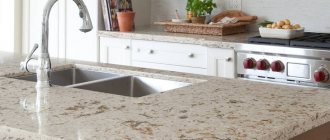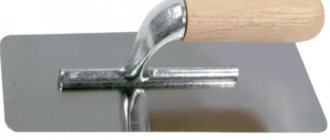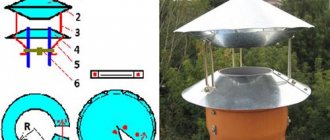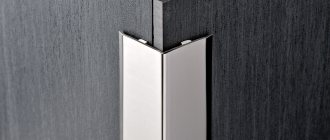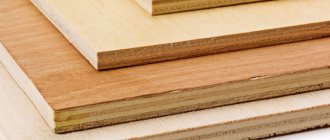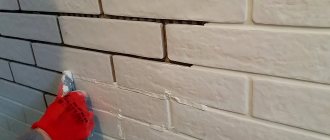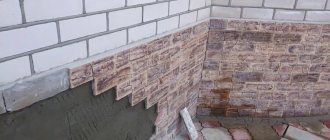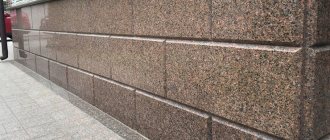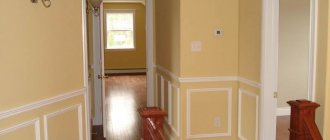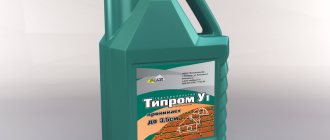Gypsum is a popular construction and finishing material that began to be used in Ancient Greece. Translated from Greek, “gypsos” means “boiling stone.” Today, beautiful park sculptures are made from it, various figures, vases, and souvenirs are carved.
Cementing materials are actively used in construction for the manufacture of panels and sanitary cabins. The production of ventilation blocks and cladding sheets cannot be done without gypsum.
Gypsum concrete products have a number of positive characteristics:
- Resistant to fire and high temperatures,
- Provide good sound insulation,
- They have a small volumetric mass.
But there are also disadvantages. One of the most significant is poor water resistance. The material absorbs water and retains it for a long time. Because of this, strength, thermal insulation, and frost-resistant properties deteriorate.
How and with what to apply water repellent?
Hydrophobic impregnation is applied last, when all construction work is completed. This is done in several ways:
- With a brush. Product consumption is less, but work time increases.
- Spray. The cost is higher, the work goes faster. When sprayed, artificial stone and joints absorb more product and are therefore more protected.
Manufacturers recommend applying the water repellent while wearing protective glasses and gloves to prevent contact with skin and mucous membranes.
Rules for applying water repellent
All solutions from domestic and Western manufacturers sold on our company’s website are suitable for use immediately after opening. It is highly recommended to carry out all work with water repellent in dry, windless weather, at a temperature of at least +10C. The procedure does not require special skills or extensive experience; most people can handle this matter on their own.
Safety precautions for waterproofing walls require protective glasses and gloves, as well as good ventilation if indoor walls are impregnated with the composition.
Before starting work, surfaces that will be coated with a moisture-proofing compound must be thoroughly cleaned and dried. If there are visible defects on the walls, such as chips and cracks, they need to be covered with cement mortar. The water repellent is applied using a brush, roller or sprayer over the entire wall area. The number of layers must be at least two (the instructions usually give the exact number of passes). Moreover, the time interval between applying one layer and the start of coating with the second should be at least 7-8 minutes. During this time, the composition does not dry out, and re-application is carried out “wet”. After 24 hours, the working surface acquires moisture-proof properties. However, during drying, do not allow the mortared stone surface to come into contact with water.
“Wet stone” effect as a decorative technique
Some water repellents can change the color of artificial stone due to the formation of a film. The color of the stone may become more saturated, like after rain. This effect has become very popular, so manufacturers began to produce special water repellents that create a “wet stone” effect. For example, Tiprom-M impregnation with the property of hydrophobization. This composition not only protects the stone, but also creates the effect of a wet surface. This impregnation can visually “update” the façade of a country house.
Impregnation of gypsum surface with primer
The primer ensures a strong bond between the finish and the underlying surface. The quality of the coating improves, it becomes durable.
The emulsion penetrates quite deeply and fills inconspicuous recesses. The polymer particles included in the composition form a durable coating. It is waterproof, but it allows air to pass through perfectly.
When the surface is properly treated with a primer, plaster and tile adhesive adhere to it much better. Sometimes manufacturers include antimicrobial additives in the composition.
Deep penetration impregnation also includes:
- Water.
- Acrylic resins are the main binder.
- Polymers. Provide deep penetration of liquid.
- Silicone agents for repelling moisture.
- Latex that improves adhesion.
Impregnation, which includes auxiliary additives, becomes universal. It can be used not only for processing gypsum, but also for wood, brick, and any other plastered surfaces.
The substance has a unique ability - it penetrates into the deepest layers. This means that even the loosest surface can be qualitatively prepared for modern finishing.
What's the result?
- 1.Hydrofobizator creates a protective film and extends the service life of artificial stone and seams, protects against the formation of efflorescence, fungus and mold.
- 2. The best water repellent for artificial stone is a solution based on organosilicon. But if you want to work at subzero temperatures, then use a composition based on silanes and siloxanes
- 3. Impregnation should be applied in 2 layers with a spray gun - using the “wet on wet” method. Particular attention is paid to the lower part of the facade, because it gets wet the most.
- 4.If the solution gets on adjacent surfaces - windows, frames or doors, wipe them with a damp cloth.
The assortment of the Unimart cybermarket includes a wide selection of water-repellent impregnations for artificial stone “Tiprom” and “Perfecta”.
Features of the use of impregnations
Modern water repellents consist of organosilicon copolymers. They are 100% safe for humans. Recommended for external and internal work, renovation of residential premises, construction of industrial buildings.
Using deep impregnation products for gypsum, in a relatively short period of time you can impart excellent water-repellent properties to the following materials and elements:
- Gypsum, gypsum polymer boards. Widely used to create facades, interiors, etc.;
- Facing tiles;
- Drywall sheets;
- Gypsum particle boards;
- Stucco;
- Small forms.
Penetrating deeply into the plaster, the impregnation reduces the formation of mold while maintaining breathability. Reduces icing and simplifies snow removal in winter. There is no surface film that could spoil the appearance of the product. The texture remains unchanged.
Water repellents for concrete: solving various problems
Concrete is one of the most popular building materials for the construction of buildings and structures, therefore its properties and composition are important for the further operation of objects. The construction of foundations, walls, platforms, use in laying bricks and forming reinforced concrete structures, etc. leave a certain imprint on the requirements for concrete. The material is durable, but has a low moisture resistance threshold due to increased porosity. Water entering these pores actively contributes to the destruction of the concrete structure and the formation of mold, provoking frequent repairs. The basement parts of buildings and foundations are especially affected.
Thanks to water repellents, concrete is less susceptible to destruction and does not require repair for a longer period
Water repellents can be added to concrete in two ways: at the stage of its production and by application to the surface of finished structures and structures. The use of an impregnation agent as an additive to a concrete solution can additionally reduce costs when organizing thermal insulation.
In addition to general properties, all hydrophobic additives for concrete have the following additional characteristics:
- increase the density of the solution and help increase the compressive strength of concrete (by 30% of the starting standard values);
- can become a replacement for plasticizers that are used in the mixture to impart plasticity;
- eliminate repair costs, as they significantly extend the life of buildings;
- raise the water resistance of concrete to grade W;
- increase frost resistance;
- if a reinforcing frame is used with concrete, then the additives simultaneously protect it from corrosion.
The Internet is replete with various ideas and recipes, and there are also tips on how to make a water repellent for concrete with your own hands. You can, of course, try, but there is a high probability that the result will be worse than you imagine, or will be completely absent. Therefore, it is recommended to buy a ready-made water repellent for concrete, which one is better to choose - in this matter, you must proceed from the purpose and the desired end result.
Water repellents can be added to concrete at the manufacturing stage or applied to the surface of finished structures
Helpful advice! When choosing an impregnation for concrete, be sure to pay attention to its purpose. Water repellent for aerated concrete and for concrete are liquids with different properties.
The price of a water repellent for concrete depends on the chosen brand and manufacturer. It can also be influenced by the multicomponent nature of the mixture, which allows for more positive qualities to be obtained for the surface being treated. Silicone-based liquids will cost more, but they have higher protective properties.
Basic criteria for choosing waterproofing liquids
To choose a specific waterproofing liquid, you should decide on the following questions:
- what surfaces will be processed (material, wet or dry base);
- the level of positive properties that it is desirable to achieve after treatment;
- versatility of use;
- manufacturer or brand.
Universal water repellents Aquasil, Ceresit and Optimist
The versatility of application is relevant when it is necessary to treat different surfaces and provide them with identical hydrophobization properties. For these purposes, the domestically produced water repellent Aquasil is suitable, which is produced in concentrated ready-made solutions and has an affordable price. It is suitable for all materials used for roofing or foundations; it reduces the water absorption of concrete, foam concrete, natural and artificial stones by 10-15, and brick by 15-40 times. At the same time, the decorative qualities of the processed materials do not suffer. The warranty without additional repairs is 10 years, but in some cases, updating the coating may not be necessary for up to 30 years of operation.
Optimist water repellents are suitable for treating a variety of surfaces
Helpful advice! Always follow the exact recipe for diluting the water repellent. An error in concentration can lead to the formation of streaks and efflorescence.
The water repellent Ceresit is, as a rule, chosen because the brand is famous, which guarantees the quality of building mixtures. In this case, this is also legal. The manufacturer has a series of several water-repellent impregnations with universal action, each of which enhances one of the characteristics. The most popular is Ceresit CT 13 for highly absorbent surfaces, except horizontal ones (paving slabs). It perfectly isolates internal small cracks up to 0.2 mm and provides an 8-12 year warranty period, during which re-impregnation is not required.
To treat various surfaces of building structures, we use the water repellent Optimist. It is not as rich in additional options as Aquasil and Ceresit, but it copes brilliantly with the task of protecting against water and dirt. In addition, the product line includes special formulations for individual processing of materials, for example, stone, wood. To protect against mold, to ensure plasticization, frost resistance of concrete, etc., special products are produced. The liquid is completely ready for use.
Home remedies for protecting plaster from moisture
- If you do not want to use industrial products, then treat the plaster surface with a varnish made from equal amounts of chalk and bleached wax. Before use, the mixed components are stirred in water (420 ml per 140 grams of mixture), after which the composition is put on fire. Bring the mixture to a boil several times and remove from heat until it becomes homogeneous. The cooled varnish is applied with a brush to the surface of the plaster several times. After drying, the surface of the stucco molding is rubbed until shiny with a soft material. This film will protect plaster products from destruction.
- You can use bleached wax dissolved in turpentine or white spirit. When using such products indoors, fire precautions must be taken and windows must be left open.
In order for moisture to get inside the molded cornices, moldings and baseboards, it is necessary to additionally seal the joints created during installation using silicone sealant.
The use of water-repellent agents increases the wear resistance of plaster, its service life and greatly facilitates maintenance. Among the produced waterproofing compounds you can find those that improve the shine of stucco or, conversely, maintain its dullness. This allows you to choose an option for the decor of a specific room.

